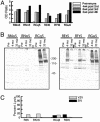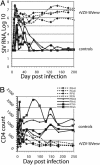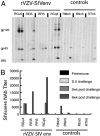Enhanced SIV replication and accelerated progression to AIDS in macaques primed to mount a CD4 T cell response to the SIV envelope protein
- PMID: 15326293
- PMCID: PMC516468
- DOI: 10.1073/pnas.0404739101
Enhanced SIV replication and accelerated progression to AIDS in macaques primed to mount a CD4 T cell response to the SIV envelope protein
Abstract
Given the dual role of CD4 T cells as both immune effectors and targets for HIV infection, the balance of CD4 versus CD8 T cell-mediated responses induced by candidate AIDS vaccines may be critical in determining postvaccination infection outcomes. An attenuated recombinant varicella-zoster virus vaccine expressing the simian immunodeficiency virus (SIV) envelope (Env) elicited nonneutralizing Env-binding antibodies and little if any cytotoxic T lymphocyte responses in rhesus macaques (Macaca mulatta). After challenge with SIV, Env vaccinees manifested increased levels of SIV replication, more rapid CD4 depletion, and accelerated progression to AIDS compared with controls. Enhanced SIV replication correlated with increased CD4 T cell proliferation soon after SIV challenge, apparently the result of an anamnestic response to SIV antigens. Thus activation of virus-specific CD4 T cells at the time of exposure to a CD4 T cell-tropic lentivirus, in the absence of an effective CD8 response, may enhance virus replication and disease. These data suggest suggest that candidate AIDS vaccines may not simply be either efficacious or neutral; they may also have the potential to be harmful.
Copyright 2004 The National Academy of Sciencs of the USA
Figures




Similar articles
-
Elite Control, Gut CD4 T Cell Sparing, and Enhanced Mucosal T Cell Responses in Macaca nemestrina Infected by a Simian Immunodeficiency Virus Lacking a gp41 Trafficking Motif.J Virol. 2015 Oct;89(20):10156-75. doi: 10.1128/JVI.01134-15. Epub 2015 Jul 29. J Virol. 2015. PMID: 26223646 Free PMC article.
-
Profound early control of highly pathogenic SIV by an effector memory T-cell vaccine.Nature. 2011 May 26;473(7348):523-7. doi: 10.1038/nature10003. Epub 2011 May 11. Nature. 2011. PMID: 21562493 Free PMC article.
-
Vaccine-induced, simian immunodeficiency virus-specific CD8+ T cells reduce virus replication but do not protect from simian immunodeficiency virus disease progression.J Immunol. 2009 Jul 1;183(1):706-17. doi: 10.4049/jimmunol.0803746. J Immunol. 2009. PMID: 19542473
-
Antiviral CD8+ T cells in the genital tract control viral replication and delay progression to AIDS after vaginal SIV challenge in rhesus macaques immunized with virulence attenuated SHIV 89.6.J Intern Med. 2009 Jan;265(1):67-77. doi: 10.1111/j.1365-2796.2008.02051.x. J Intern Med. 2009. PMID: 19093961 Free PMC article. Review.
-
Determining the immune mechanisms of protection from AIDS: correlates of immunity and the development of syngeneic macaques.Immunol Rev. 2001 Oct;183:94-108. doi: 10.1034/j.1600-065x.2001.1830108.x. Immunol Rev. 2001. PMID: 11782250 Review.
Cited by
-
Balance of cellular and humoral immunity determines the level of protection by HIV vaccines in rhesus macaque models of HIV infection.Proc Natl Acad Sci U S A. 2015 Mar 3;112(9):E992-9. doi: 10.1073/pnas.1423669112. Epub 2015 Feb 13. Proc Natl Acad Sci U S A. 2015. PMID: 25681373 Free PMC article.
-
Lymphocyte proliferation responses induced to broadly reactive Th peptides did not protect against equine infectious anemia virus challenge.Clin Diagn Lab Immunol. 2005 Aug;12(8):983-93. doi: 10.1128/CDLI.12.8.983-993.2005. Clin Diagn Lab Immunol. 2005. PMID: 16085917 Free PMC article.
-
How can HIV-type-1-Env immunogenicity be improved to facilitate antibody-based vaccine development?AIDS Res Hum Retroviruses. 2012 Jan;28(1):1-15. doi: 10.1089/aid.2011.0053. Epub 2011 May 20. AIDS Res Hum Retroviruses. 2012. PMID: 21495876 Free PMC article. Review.
-
Novel Concepts for HIV Vaccine Vector Design.mSphere. 2017 Dec 6;2(6):e00415-17. doi: 10.1128/mSphere.00415-17. eCollection 2017 Nov-Dec. mSphere. 2017. PMID: 29242831 Free PMC article. Review.
-
Divergent host responses during primary simian immunodeficiency virus SIVsm infection of natural sooty mangabey and nonnatural rhesus macaque hosts.J Virol. 2005 Apr;79(7):4043-54. doi: 10.1128/JVI.79.7.4043-4054.2005. J Virol. 2005. PMID: 15767406 Free PMC article.
References
-
- Douek, D. C., Brenchley, J. M., Betts, M. R., Ambrozak, D. R., Hill, B. J., Okamoto, Y., Casazza, J. P., Kuruppu, J., Kunstman, K., Wolinsky, S., et al. (2002) Nature 417, 95-98. - PubMed
-
- Krause, P. R. & Klinman, D. M. (2000) Nat. Med. 6, 451-454. - PubMed
-
- Institute of Laboratory Animal Resources, National Research Council (1996) Guide for the Care and Use of Laboratory Animals (Natl. Acad. Press, Washington, DC).
Publication types
MeSH terms
Substances
Grants and funding
LinkOut - more resources
Full Text Sources
Research Materials

